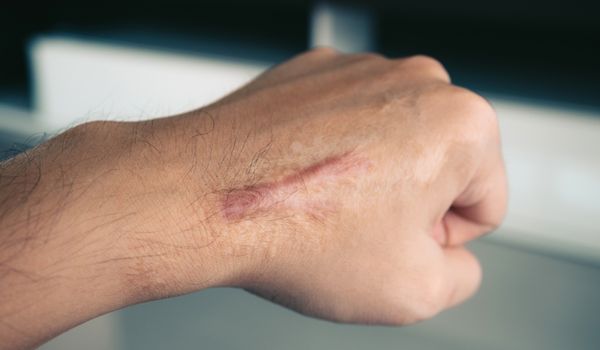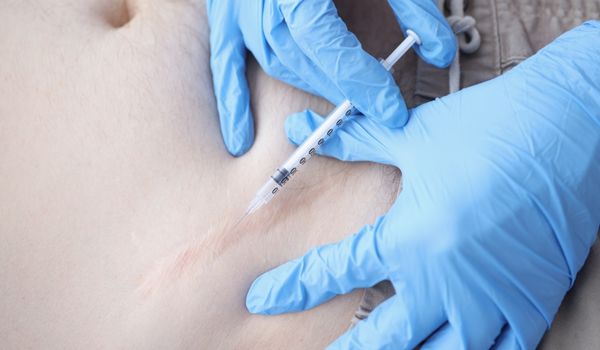
Causes, Treatments and Prevention of Hypertrophic and Keloid Scars after Plastic Surgery
Keloids and hypertrophic scars are thick and elevated scars that can develop after plastic surgery. They form when the body produces too much collagen and scar tissue while healing a wound.
Hypertrophic scars and keloids have similar causes and treatments. However, keloids are usually bigger, thicker, and more elevated than hypertrophic scars. They’re also harder to treat.
Although not dangerous, these abnormal scars can become a cosmetic concern. You can treat a hypertrophic scar or a keloid at home or with the help of your doctor.
Learn more about how hypertrophic and keloid scars form after cosmetic surgery, how to treat them, and what you can do to prevent them.
Why Do Scars Form After Plastic surgery?
Scars are a natural result of the body’s wound healing process. To perform any plastic surgery, your surgeon makes at least one skin incision.
When the skin is injured, the body deposits collagen and other molecules into the wound to promote tissue growth and help the injury heal. The build-up of these molecules leads to scar tissue formation.
Over the months, the skin tissues undergo remodelling as the wound continues to heal. Eventually, normal scars flatten, soften, and fade into a lighter colour.
Abnormal scarring can occur if the body produces too much collagen to heal the wound, which leads to hypertrophic scars or keloids.
What Are Hypertrophic Scars After Plastic Surgery?
A hypertrophic scar is an atypical scar that appears thick, wide, and slightly raised after the wound has healed. Hypertrophic scars occur after cosmetic surgery because of abnormal scarring during wound healing.
This abnormal scarring can appear 1-2 months after plastic surgery, especially where the skin is tight (areas of skin tension).
In general, a hypertrophic scar that develops following plastic surgery has the following characteristics:
- It has a pink to red colour
- It looks slightly raised above skin level
- It can occur anywhere on the body but is more common in areas with taut skin
Hypertrophic scars aren’t dangerous and don’t cause any health concerns. However, they can become itchy or painful and are often a cosmetic concern.
What Are Keloids After Plastic Surgery?
Keloids are enlarged, raised scars that appear as smooth, hard growths on the skin. They’re another form of abnormal scarring that can happen after cosmetic surgery.
These elevated scars can develop months to years after plastic surgery and can occur anywhere on the body.
Generally, a keloid after cosmetic surgery appears much larger than the original wound and can have the following characteristics:
- It’s darker than the surrounding skin (has a red to purple colour)
- It can continue to grow larger over time
- It looks like a lump raised above the skin level
Similarly to hypertrophic scars, keloids are a cosmetic concern rather than a health concern. Although keloid scars may be itchy, tender, or feel uncomfortable, they are not a health problem.
What Causes Hypertrophic Scars and Keloids after Plastic Surgery?
Hypertrophic scars and keloids can develop after cosmetic surgery because of excessive collagen production and overgrowth of tissue during wound healing.
The overproduction of collagen can happen due to:
- Wound infection: a wound infection after cosmetic surgery can prolong skin inflammation. As a result, inflammatory cells increase collagen production, which leads to abnormal scarring after plastic surgery
- Wound tension: to close your incision, your surgeon pulls the edges of your skin together tightly and then sutures the wound. That creates wound tension, especially if the skin around the incision is already tight. The additional tension can increase wound inflammation and lead to excess collagen deposits. Consequently, keloids and hypertrophic scars form following plastic surgery
- Genetics: each person has a different skin type and different healing tendencies. Some patients are genetically predisposed to excessive scarring and are more likely to develop hypertrophic and keloid scars after cosmetic surgery
A study revealed that people with darker skin are more prone to developing keloids and hypertrophic scars. The lowest incidence of hypertrophic scarring appeared in individuals with albinism who have skin with little to no colour.
Hypertrophic Scars vs. Keloid Scars after Plastic Surgery
Keloids are often confused with hypertrophic scars and vice versa. It’s important to differentiate between the two types of raised scars because their treatment may differ.
Both are elevated scars that result from excess scar tissue during wound healing. The main differences between keloids and hypertrophic scars include:
- Hypertrophic scars typically develop 1-2 months after plastic surgery, whereas keloids can take months to years to form
- Hypertrophic scars are usually smaller and closer to the skin level, unlike keloids which can grow very large and beyond the wound area
- Keloids can range from red to purple and may be noticeably darker than the surrounding skin. On the other hand, hypertrophic scars usually have a lighter colour ranging from red to pink
- Hypertrophic scars may become less noticeable with time, even without treatment. Contrarily, keloids often do not resolve on their own
How to Treat Hypertrophic Scars and Keloids after Plastic Surgery?
Sometimes, it can take up to a year for a wound to fully heal and for your scars to mature. Therefore, your surgeon may wait several months before starting your keloid or hypertrophic scar treatment.
Several treatments can help shrink and flatten hypertrophic scars and keloids from cosmetic surgery.
Initially, surgeons usually recommend at-home treatments for excessive scarring. Later your surgeon might suggest different medical treatments if your scar doesn’t improve or if a keloid starts growing larger.
Home Remedies for Keloid and Hypertrophic Scars
Several things can help you get rid of your postoperative hypertrophic scars and keloids at home, including:
- Silicone gels or sheets: silicone-based products can help improve the appearance of hypertrophic and keloid scars after cosmetic surgery. Patients can use silicone sheets, gels, foams, and sprays as soon as their wounds heal. Self-adhesive silicone sheets must be worn 12-24 hours a day, every day, for several months. Topical silicone gels are the preferred first line of treatment for keloids and hypertrophic scars after plastic surgery
- Pressure dressings: one of the most cost-effective ways to naturally manage hypertrophic and keloid scars after cosmetic surgery is by applying pressure to and massaging the scar area. You can use pressure garments such as ACE bandages, elastic wraps, or tape to apply pressure to your scars. The pressure helps reduce the scar tissue and flatten the scar
- Other OTC treatments for scars: over-the-counter (OTC) treatments such as Bio Skin Oil and onion extract gels have been shown effective in reducing the appearance of scars. More research is still needed to confirm whether these two products can reduce hypertrophic or keloid scars
Medical Treatment of Hypertrophic Scars and Keloids
- Corticosteroid injections: steroid injections are a first-line medical treatment for hypertrophic and keloid scars after plastic surgery. Your surgeon will inject your elevated scar with a steroid every 4-6 weeks to help smoothen and flatten it. The steroids can also help reduce itching and discomfort
- Cryotherapy: during cryotherapy, your surgeon will freeze the scar tissue using liquid nitrogen. After 10-20 seconds, the tissue is allowed to thaw. Then, this process is repeated multiple times. The extremely cold temperatures eventually destroy the excess scar tissue
- Laser therapy: Laser therapy is usually more effective for newly formed scars than older scars. This therapy can improve the appearance of hypertrophic and keloid scars after cosmetic surgery. It can also reduce the redness, itching, and discomfort and decrease the size of a keloid
- Bleomycin injections: bleomycin is an antibiotic that can destroy cells and is commonly used as an anti-cancer drug. However, studies revealed that Bleomycin injections can improve the appearance of hypertrophic scars and keloids after plastic surgery
- Surgical removal: the surgical excision of a raised scar after cosmetic surgery is usually a last-resort treatment. Your surgeon may surgically remove a keloid or hypertrophic scar if it doesn’t improve with at-home treatments or other medical scar therapies. There’s a high chance that a keloid will return after its surgical removal. Nonetheless, in the case of very large keloids, the benefits of surgery may outweigh the risks of recurring scars
The treatment choice of an elevated scar after cosmetic surgery depends on several factors, such as whether it is keloid or hypertrophic, small or large, and how much it’s bothering you.
Keloid scars are usually harder to treat than hypertrophic ones. Non-invasive scar therapies such as silicone sheets, pressure dressings, and massages are less effective in treating keloids than hypertrophic scars.
The effective treatment of keloids usually requires a combination of different therapies.
How to Prevent Hypertrophic and Keloid Scars after Plastic Surgery?
Although sometimes unavoidable, several precautions can reduce your risk of developing a hypertrophic scar or a keloid after plastic surgery, such as:
- Wound care: keep your wound clean and well protected after cosmetic surgery. A dirty or exposed wound can become infected and cause abnormal wound scarring
- Silicone gel and sheets: in addition to treating postoperative scars, silicone can help prevent the formation of hypertrophic and keloid scars after plastic surgery. The silicone keeps the scar hydrated and decreases collagen production
- Scar massages: massages are a cheap and effective way to prevent your scars from worsening. Scar messages can keep the scar tissue soft and aid in the degradation of excessive collagen deposits. That can help you avoid keloids or hypertrophic scars after cosmetic surgery
- Pressure dressings: the pressure from garments, tapes, or wraps can help disrupt the build-up of collagen and prevent hypertrophic scar or keloid formation
- Avoid exposing your scars to the sun: sun exposure can darken your scars and make them look worse. Use sunscreen generously and keep your scars covered when you’re out in the sun
Although keloids and hypertrophic scars after cosmetic surgery rarely cause any health complications, you may be bothered by their appearance. Your surgeon can treat these scars even years after they appear.
If your scar after plastic surgery looks off or is bothering you, ask your surgeon about possible treatment options.
Medical References about Scars after Plastic Surgery
- Collagen in Wound Healing – PMC
- Hypertrophic Scarring – StatPearls – NCBI Bookshelf
- Management of keloids and hypertrophic scars: current and emerging options – PMC
Further Information Related to Plastic Surgery Scars
- Recovery after Plastic Surgery – Dr. Guy Watts
- Tips to Reduce Scars after Your Tummy Tuck/ Abdominoplasty Procedure
- How to Minimise Scars after Gynaecomastia – Dr Bish Soliman
- Managing Plastic Surgery Scars – Dr. Mark Doyle
- Scar Revision Surgery Sydney by Dr Michael Kernohan
- How to Minimise Scars after Breast Lift by Dr Jake Lim


